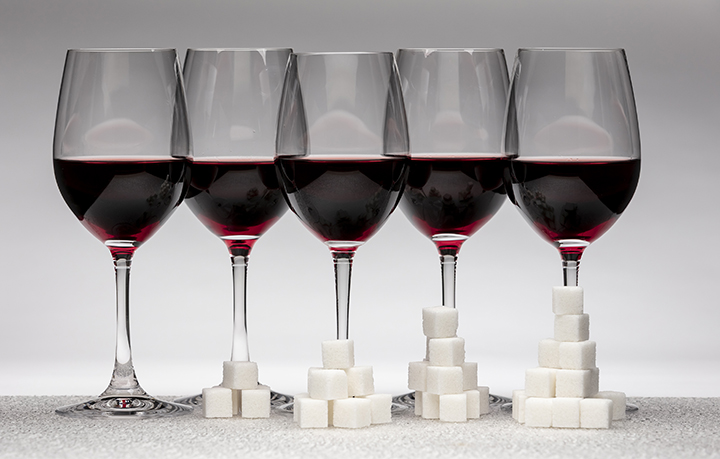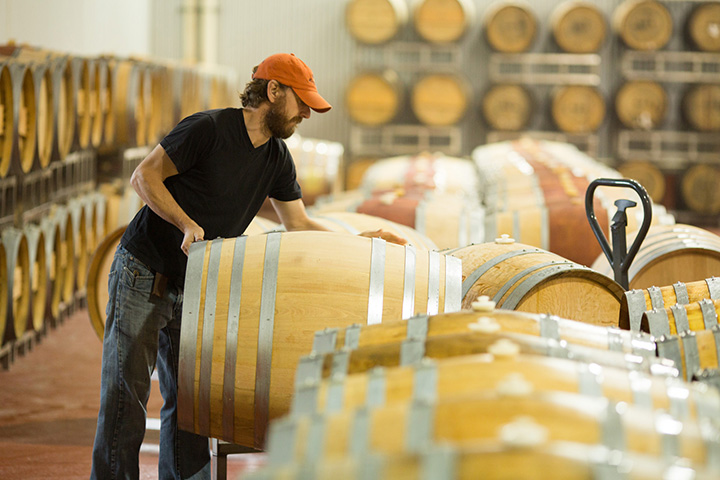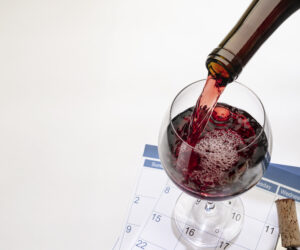In 2018, after another vintage was impacted by heavy rain that diluted grapes and lowered their sugar concentrations, Matthieu Finot decided to conduct some chaptalization experiments. The winemaker at King Family Vineyards in Crozet, Virginia, wanted to investigate the effect of alcohol level on the sensory perception of ripeness. The state’s Wine-makers Research Exchange (WRE), which he helped establish, supported his endeavors.
Finot’s findings should give winemakers in Virginia and beyond more confidence when they use chaptalization to offset the impacts of grapes diluted by rain or that are harvested underripe from a cooler climate. He told WineMaker all about his experiments so you can add this technique to your winemaking toolbox.

For those unfamiliar with the practice, chaptalization is the process of adding sugar during fermentation for the purpose of boosting a wine’s final alcohol content. The process is named after the Frenchman who perfected it more than 200 years ago: Jean-Antoine Chaptal, the Count of Chanteloup, an early pioneer of modern winemaking.
Chaptal was imprisoned during the French Revolution, knighted by Napoleon Bonaparte, and became famous enough as an agronomist and chemist to have his name engraved on the Eiffel Tower, where you can still find it. He’s also buried in Père Lachaise Cemetery in Paris near other luminaries like The Door’s frontman Jim Morrison and author Oscar Wilde.
The French Connection (Gene Hackman, RIP) continues through Finot, who was born into a family of viticulturists in the northern Rhône wine region of Crozes-Hermitage. He traveled the world perfecting his winemaking skills before settling in Virginia where he’s made the wine for the King Family for most of the last two decades.
In cooler climates like Virginia, chaptalization is often used by winemakers to compensate for underripe grapes or the diluting effects of rain. Finot says he’s used it since his early winemaking days in France.
“In Virginia, we are in a location where we could easily get heavy rainfall during harvest due to the hurricanes,” he says. “You can always bleed, or do a saignée, to concentrate your wine when you’ve got heavy rains.”
However, he says while the saignée method (in which a portion of the juice is separated from a red must shortly after pressing) concentrates the wine, the sugar levels can still be low.
“So, the way to compensate is to raise your alcohol level in your wine by doing a chaptalization,” says Finot.
So together with saignée, chaptalization is dealing with the two major impacts that come from heavy rain before harvest.
“You concentrate your tannin and color by doing the bleeding earlier on and then raise your sugar level back to what it’s supposed to be (through chaptalization),” he says.
Don’t Stop ’Til You Get Enough?
One question about chaptalization Finot wanted to answer through trials was just how much sugar is the optimum amount to add?
In Europe, the amount of sugar a commercial winemaker can add is limited and depends on the region. The maximum amount you can raise the alcohol level ranges up to 3%, though it varies by country and regions within countries. Generally, cooler climates allow for higher sugar additions. There are actually no federal regulations in the United States for how much sugar may be added, though individual states are able to set their own regulations and professional winemakers in California are not permitted to chaptalize. This makes sense for California as grape growers in the state do not suffer the same troubles growers in other regions sometimes encounter with cooler weather and heavier fall rains.
As 1.5% or 2% is the limit in many parts of France and other wine regions in Europe, Finot aimed for similar addition rates when his Virginia wines needed sugar assistance. However, in 2018 he decided to add different amounts of sugar, sometimes much higher than he’d ever done before, to see what the result would be.
“I think for me, the point of this experimentation was to go over my own personal limits,” he says.

Due to heavy rain, Finot said that year was not a great vintage and he was already planning to chaptalize some of the wines. “I had a lot of Cabernet Sauvignon that was very, very low Brix,” says Finot.
He said Cab doesn’t perform very well in Virginia due to heavy clay soils even when there isn’t rainy weather. Add in higher than average rains, and the grape needed some work to be made into wine.
“I decided it was a good candidate to play with and so instead of sticking to my usual 1.5% increase in alcohol, I decided to go further than that,” says Finot. “We did one batch with no sugar, another batch with 30 grams per liter of sugar. That’s going to get you 1.5% more alcohol,” says Finot. For a third batch their sugar addition was 60 grams per liter, boosting the alcohol level 3%.
The results were tasted by a panel of Virginia winemakers and scored for sensory qualities. Finot suggested that he was surprised by his results.
“What I did find very interesting was that the sensory perception of the wine (after sugar additions) was completely different,” says Finot.
He says there were also very clear differences between the ripeness perceptions experienced by the Virginia winemakers for each of the different experimental batches. The experiment involved converting Cabernet Sauvignon grapes that came in at about 19 °Brix (which would make a 10.3% alcohol wine) to one batch at 12% alcohol and a second batch at around 13%.
“So that’s an increase of almost 3% alcohol by volume and I think it was tasting better than the wine we raised by almost 2%,” says Finot.
Most other winemakers on the tasting panel agreed.
“Most people found the one with no sugar added very green, thin, and lacking volume or body,” says Finot. “The wine with the highest level of sugar was perceived to be much riper with more structure and more volume.”
Finot has also done chaptalization experiments with both Malbec and Merlot with similar results. One main lesson from his experiments, he says, is that “over-chaptalizing is probably the best way to compensate” when the aim is to boost the perception of ripeness in a wine. However, he believes around 13% ABV is the alcohol level “sweet spot.”
“You don’t want to get a wine at 15% alcohol, I’m sure that’s not going to work very well,” he says. “But now I’m much less scared to add what’s needed in the wine in a very bad year to really get wines closer to the sweet spot of 13% alcohol, instead of targeting only 11.5% or 12%.”
Judicial Use is Important
Finot’s interest in chaptalization does not mean Virginia’s winemakers are adding sugars to their wine every year. For most vintages, he says, the weather doesn’t pile on the rain and they harvest grapes with full phenolic ripeness and adequate natural sugar levels. “Most of time, we don’t have to do it,” he says. “With your reds (in Virginia), you can push them to ripen, and they ripen fine but then suddenly you start getting lots of rain — that’s where you want to be able to use these techniques.”
However, 2003, 2011, 2018 and 2022 are some recent seasons where at least some chaptalization was necessary.
“Last year (2024), we had a perfect example of a challenging year with a very early vintage,” he says. “Everything was getting ripe earlier, including the reds, and we were very happy.”
Then news came that a hurricane was on the way so they harvested their grapes before the weather arrived to avoid the diluting impact of the rain that would come with it.

“I think I had a batch of Petit Verdot that was a little less ripe than I wanted it to be, so I did some chaptalization on that,” he says.
Finot says it is important to assess the wine before chaptalizing. Some wines, says Finot, taste absolutely fine at a lower alcohol level.
“Ultimately, it is not something that we are looking to do, but knowing that you can do it in a bad year allows me to still be able to produce some quality wine, even in more challenging weather,” says Finot.
Is Adding Sugar to Wine Ever Controversial?
Despite its usefulness as a winemaking tool, there is some controversy around commercial wineries adding sugar to wine. Most of that negative vibe could be connected to sugar additions after fermentation that boost the sweetness of the wine, or adding it with the intent of covering winemaking faults, rather than chaptalization.
Whatever the reason for the sometimes negative feedback, Finot is a very strong supporter of chaptalization.
“I’m from the northern Rhône and I’ve studied in Burgundy and those are two places where chaptalization is something that’s completely accepted,” he says.
The technique, he says, has the advantage of improving body, volume, and mouthfeel without adding enological products, like tannins and mannoproteins. “It’s something where you still keep the identity of the wine,” says Finot.
Chaptalization is also appealing for winemakers, he says, because by focusing on that “one target,” which is the sugar level, you can have a significant impact on the quality of the resulting wine.
He also pointed to California where winemakers can have the opposite problem to Virginia — overripe grapes with too much sugar. On the West Coast winemakers often add water to fermentations to dilute the sugar levels in case they create high alcohol levels that either cause stuck fermentations or wines that are too “hot” to drink.
“Is adding water any worse? Everybody has to adapt what they do with what they’ve got and in California, much of the time, they need to add water to their wine to be able to finish their fermentation,” says Finot.
He says in Virginia his experiments have helped him reach the conclusion that the best way to compensate for a lack of ripeness or dilution of the wine is to chaptalize “and not rely on other enological products.”
How to Add Sugar to Your Wine?
So how should a home winemaker go about adding sugar to fermenting wine? And what type of sugar can be added? Finot’s experiments also trialed different types of sweet additions.
“White sugar is probably the easiest and the most neutral one to add,” says Finot.
There are plenty of options, though white sugar (aka table or granulated sugar) is likely easier and less expensive than finding a suitable fruit concentrate or another type of sweetener. For example, brown sugar does impact the flavor a little, he says, and is usually much more expensive than its white, more processed cousin.
The actual technique of adding sugar is “very easy” he says. “It’s very easy to put in place, as long as you know the rate of fermentation and how many grams of sugar it takes to produce 1% alcohol,” says Finot.
Finot usually does any sugar additions about halfway through the fermentation. “You don’t want to add it too late in the fermentation because you don’t want to get a stuck fermentation with sugar left over,” says Finot.
He pulls enough of the fermenting juice from the must to dissolve the sugar, stirs the sugar into it until it is completely dissolved, and then returns it to the tank. Once added back, punch down or stir it into the fermenting must so it fully incorporates.
Finot warns against simply dumping sugar into the must. “It’s better to dilute it in juice and put it back in, otherwise it might settle down at the bottom of your tank and you won’t get the effect that you want,” says Finot.
Now it’s your turn!





